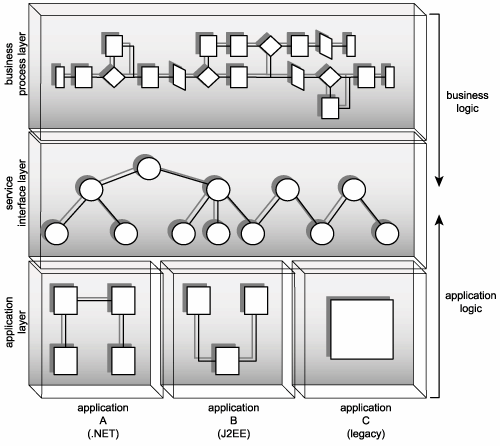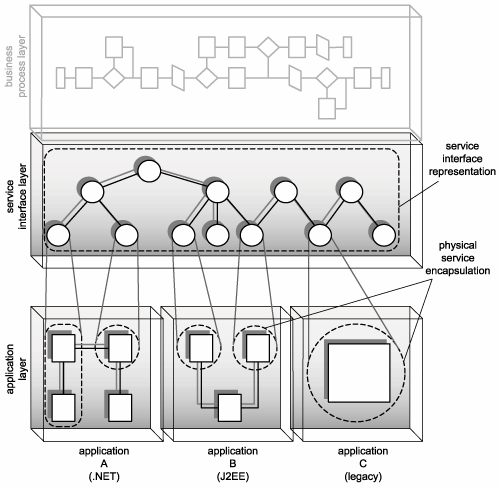Service-orientation and the enterprise
The collective logic that defines and drives an enterprise is an ever-evolving entity constantly changing in response to external and internal influences. From an IT perspective, this enterprise logic can be divided into two important halves: business logic and application logic (Figure 8.1).
Figure 8.1. The business and application logic domains.

Each exists in a world of its own, and each represents a necessary part of contemporary organization structure. Business logic is a documented implementation of the business requirements that originate from an enterprise's business areas. Business logic is generally structured into processes that express these requirements, along with any associated constraints, dependencies, and outside influences.
Application logic is an automated implementation of business logic organized into various technology solutions. Application logic expresses business process workflows through purchased or custom-developed systems within the confines of an organization's IT infrastructure, security constraints, technical capabilities, and vendor dependencies.
Service-orientation applies to enterprise logic. It introduces new concepts that augment the manner in which this logic is represented, viewed, modeled, and shared. While the principles behind service-orientation exist in a vacuous realm of abstraction and theory, they are a necessary counterpart to the real world environments that require their guidance and structure.
The concepts introduced by service-orientation are realized through the introduction of services. Let's have a look at where services are located within the overall structure of an automated organization. As Figure 8.2 illustrates, services establish a high form of abstraction wedged between traditional business and application layers. When positioned here, services can encapsulate physical application logic as well as business process logic.
Figure 8.2. The service interface layer positioned between enterprise layers that promote application and business logic.

Services modularize the enterprise, forming standalone units of logic that exist within a common connectivity layer. Services can be layered so that parent services can encapsulate child services. This allows for the service layer to consist of multiple layers of abstraction (as explained later in Chapter 9).
In Figure 8.2 we display a fragmented application layer, where individual applications are confined to the boundaries that represent their respective proprietary platform environments. Though we show services as existing in a single, continuous layer, this only illustrates the open connectivity that exists among service interfaces. Freed from proprietary ties, services can communicate via open protocols.
On a physical level, services are developed and deployed in proprietary environments, wherein they are individually responsible for the encapsulation of specific application logic. Figure 8.3 shows how individual services, represented as service interfaces within the service interface layer, represent application logic originating from different platforms.
Figure 8.3. The service interface layer abstracts connectivity from service deployment environments.

|
SUMMARY OF KEY POINTS |
|---|
|
Introduction
- Why this book is important
- Objectives of this book
- Who this book is for
- What this book does not cover
- How this book is organized
- Additional information
Case Studies
- Case Studies
- How case studies are used
- Case #1 background: RailCo Ltd.
- Case #2 background: Transit Line Systems Inc.
Part I: SOA and Web Services Fundamentals
Introducing SOA
- Introducing SOA
- Fundamental SOA
- Common characteristics of contemporary SOA
- Common misperceptions about SOA
- Common tangible benefits of SOA
- Common pitfalls of adopting SOA
The Evolution of SOA
- The Evolution of SOA
- An SOA timeline (from XML to Web services to SOA)
- The continuing evolution of SOA (standards organizations and contributing vendors)
- The roots of SOA (comparing SOA to past architectures)
Web Services and Primitive SOA
- Web Services and Primitive SOA
- The Web services framework
- Services (as Web services)
- Service descriptions (with WSDL)
- Messaging (with SOAP)
Part II: SOA and WS-* Extensions
Web Services and Contemporary SOA (Part I: Activity Management and Composition)
- Web Services and Contemporary SOA (Part I: Activity Management and Composition)
- Message exchange patterns
- Service activity
- Coordination
- Atomic transactions
- Business activities
- Orchestration
- Choreography
Web Services and Contemporary SOA (Part II: Advanced Messaging, Metadata, and Security)
- Web Services and Contemporary SOA (Part II: Advanced Messaging, Metadata, and Security)
- Addressing
- Reliable messaging
- Correlation
- Policies
- Metadata exchange
- Security
- Notification and eventing
Part III: SOA and Service-Orientation
Principles of Service-Orientation
- Principles of Service-Orientation
- Service-orientation and the enterprise
- Anatomy of a service-oriented architecture
- Common principles of service-orientation
- How service-orientation principles inter-relate
- Service-orientation and object-orientation (Part II)
- Native Web service support for service-orientation principles
Service Layers
- Service Layers
- Service-orientation and contemporary SOA
- Service layer abstraction
- Application service layer
- Business service layer
- Orchestration service layer
- Agnostic services
- Service layer configuration scenarios
Part IV: Building SOA (Planning and Analysis)
SOA Delivery Strategies
- SOA Delivery Strategies
- SOA delivery lifecycle phases
- The top-down strategy
- The bottom-up strategy
- The agile strategy
Service-Oriented Analysis (Part I: Introduction)
- Service-Oriented Analysis (Part I: Introduction)
- Service-oriented architecture vs. Service-oriented environment
- Introduction to service-oriented analysis
- Benefits of a business-centric SOA
- Deriving business services
Service-Oriented Analysis (Part II: Service Modeling)
- Service-Oriented Analysis (Part II: Service Modeling)
- Service modeling (a step-by-step process)
- Service modeling guidelines
- Classifying service model logic
- Contrasting service modeling approaches (an example)
Part V: Building SOA (Technology and Design)
Service-Oriented Design (Part I: Introduction)
- Service-Oriented Design (Part I: Introduction)
- Introduction to service-oriented design
- WSDL-related XML Schema language basics
- WSDL language basics
- SOAP language basics
- Service interface design tools
Service-Oriented Design (Part II: SOA Composition Guidelines)
- Service-Oriented Design (Part II: SOA Composition Guidelines)
- Steps to composing SOA
- Considerations for choosing service layers
- Considerations for positioning core SOA standards
- Considerations for choosing SOA extensions
Service-Oriented Design (Part III: Service Design)
- Service-Oriented Design (Part III: Service Design)
- Service design overview
- Entity-centric business service design (a step-by-step process)
- Application service design (a step-by-step process)
- Task-centric business service design (a step-by-step process)
- Service design guidelines
Service-Oriented Design (Part IV: Business Process Design)
- Service-Oriented Design (Part IV: Business Process Design)
- WS-BPEL language basics
- WS-Coordination overview
- Service-oriented business process design (a step-by-step process)
Fundamental WS-* Extensions
- Fundamental WS-* Extensions
- You mustUnderstand this
- WS-Addressing language basics
- WS-ReliableMessaging language basics
- WS-Policy language basics
- WS-MetadataExchange language basics
- WS-Security language basics
SOA Platforms
Appendix A. Case Studies: Conclusion
EAN: 2147483647
Pages: 150
